[English] 日本語
 Yorodumi
Yorodumi- PDB-7n75: Cryo-EM structure of ATP13A2 D458N/D962N mutant in the E1-apo sta... -
+ Open data
Open data
- Basic information
Basic information
| Entry | Database: PDB / ID: 7n75 | ||||||
|---|---|---|---|---|---|---|---|
| Title | Cryo-EM structure of ATP13A2 D458N/D962N mutant in the E1-apo state, Conformation 1 | ||||||
 Components Components | Isoform 3 of Polyamine-transporting ATPase 13A2 | ||||||
 Keywords Keywords | TRANSPORT PROTEIN / P-type ATPase / P5B-ATPase / polyamine transporter | ||||||
| Function / homology |  Function and homology information Function and homology informationregulation of glucosylceramidase activity / : / : / : / ABC-type polyamine transporter activity / polyamine transmembrane transport / spermine transmembrane transport / peptidyl-aspartic acid autophosphorylation / regulation of ubiquitin-specific protease activity / regulation of autophagosome size ...regulation of glucosylceramidase activity / : / : / : / ABC-type polyamine transporter activity / polyamine transmembrane transport / spermine transmembrane transport / peptidyl-aspartic acid autophosphorylation / regulation of ubiquitin-specific protease activity / regulation of autophagosome size / extracellular exosome biogenesis / regulation of chaperone-mediated autophagy / negative regulation of lysosomal protein catabolic process / autophagosome-lysosome fusion / regulation of autophagy of mitochondrion / regulation of lysosomal protein catabolic process / intracellular monoatomic cation homeostasis / autophagosome organization / protein localization to lysosome / phosphatidic acid binding / multivesicular body membrane / positive regulation of exosomal secretion / ATPase-coupled monoatomic cation transmembrane transporter activity / vesicle membrane / intracellular zinc ion homeostasis / regulation of protein localization to nucleus / Translocases; Catalysing the translocation of other compounds; Linked to the hydrolysis of a nucleoside triphosphate / cupric ion binding / regulation of endopeptidase activity / regulation of mitochondrion organization / phosphatidylinositol-3,5-bisphosphate binding / cellular response to zinc ion / lysosomal transport / regulation of intracellular protein transport / lipid homeostasis / autophagosome membrane / Ion transport by P-type ATPases / autophagosome / cellular response to manganese ion / regulation of macroautophagy / transport vesicle / monoatomic ion transmembrane transport / multivesicular body / lysosomal lumen / positive regulation of protein secretion / autophagy / intracellular calcium ion homeostasis / late endosome / manganese ion binding / cellular response to oxidative stress / intracellular iron ion homeostasis / vesicle / protein autophosphorylation / membrane => GO:0016020 / lysosome / neuron projection / lysosomal membrane / neuronal cell body / positive regulation of gene expression / ATP hydrolysis activity / zinc ion binding / ATP binding Similarity search - Function | ||||||
| Biological species |  Homo sapiens (human) Homo sapiens (human) | ||||||
| Method | ELECTRON MICROSCOPY / single particle reconstruction / cryo EM / Resolution: 2.9 Å | ||||||
 Authors Authors | Sim, S.I. / Park, E. | ||||||
| Funding support |  United States, 1items United States, 1items
| ||||||
 Citation Citation |  Journal: Mol Cell / Year: 2021 Journal: Mol Cell / Year: 2021Title: Structural basis of polyamine transport by human ATP13A2 (PARK9). Authors: Sue Im Sim / Sören von Bülow / Gerhard Hummer / Eunyong Park /   Abstract: Polyamines are small, organic polycations that are ubiquitous and essential to all forms of life. Currently, how polyamines are transported across membranes is not understood. Recent studies have ...Polyamines are small, organic polycations that are ubiquitous and essential to all forms of life. Currently, how polyamines are transported across membranes is not understood. Recent studies have suggested that ATP13A2 and its close homologs, collectively known as P5B-ATPases, are polyamine transporters at endo-/lysosomes. Loss-of-function mutations of ATP13A2 in humans cause hereditary early-onset Parkinson's disease. To understand the polyamine transport mechanism of ATP13A2, we determined high-resolution cryoelectron microscopy (cryo-EM) structures of human ATP13A2 in five distinct conformational intermediates, which together, represent a near-complete transport cycle of ATP13A2. The structural basis of the polyamine specificity was revealed by an endogenous polyamine molecule bound to a narrow, elongated cavity within the transmembrane domain. The structures show an atypical transport path for a water-soluble substrate, in which polyamines may exit within the cytosolic leaflet of the membrane. Our study provides important mechanistic insights into polyamine transport and a framework to understand the functions and mechanisms of P5B-ATPases. | ||||||
| History |
|
- Structure visualization
Structure visualization
| Movie |
 Movie viewer Movie viewer |
|---|---|
| Structure viewer | Molecule:  Molmil Molmil Jmol/JSmol Jmol/JSmol |
- Downloads & links
Downloads & links
- Download
Download
| PDBx/mmCIF format |  7n75.cif.gz 7n75.cif.gz | 182.7 KB | Display |  PDBx/mmCIF format PDBx/mmCIF format |
|---|---|---|---|---|
| PDB format |  pdb7n75.ent.gz pdb7n75.ent.gz | 138 KB | Display |  PDB format PDB format |
| PDBx/mmJSON format |  7n75.json.gz 7n75.json.gz | Tree view |  PDBx/mmJSON format PDBx/mmJSON format | |
| Others |  Other downloads Other downloads |
-Validation report
| Summary document |  7n75_validation.pdf.gz 7n75_validation.pdf.gz | 1.1 MB | Display |  wwPDB validaton report wwPDB validaton report |
|---|---|---|---|---|
| Full document |  7n75_full_validation.pdf.gz 7n75_full_validation.pdf.gz | 1.1 MB | Display | |
| Data in XML |  7n75_validation.xml.gz 7n75_validation.xml.gz | 43.7 KB | Display | |
| Data in CIF |  7n75_validation.cif.gz 7n75_validation.cif.gz | 64.9 KB | Display | |
| Arichive directory |  https://data.pdbj.org/pub/pdb/validation_reports/n7/7n75 https://data.pdbj.org/pub/pdb/validation_reports/n7/7n75 ftp://data.pdbj.org/pub/pdb/validation_reports/n7/7n75 ftp://data.pdbj.org/pub/pdb/validation_reports/n7/7n75 | HTTPS FTP |
-Related structure data
| Related structure data |  24220MC  7n70C  7n72C  7n73C  7n74C  7n76C  7n77C  7n78C M: map data used to model this data C: citing same article ( |
|---|---|
| Similar structure data |
- Links
Links
- Assembly
Assembly
| Deposited unit | 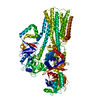
|
|---|---|
| 1 |
|
- Components
Components
| #1: Protein | Mass: 128442.500 Da / Num. of mol.: 1 / Mutation: D458N, D962N Source method: isolated from a genetically manipulated source Source: (gene. exp.)  Homo sapiens (human) / Gene: ATP13A2, PARK9 / Production host: Homo sapiens (human) / Gene: ATP13A2, PARK9 / Production host:  References: UniProt: Q9NQ11-3, Translocases; Catalysing the translocation of other compounds; Linked to the hydrolysis of a nucleoside triphosphate |
|---|---|
| #2: Water | ChemComp-HOH / |
-Experimental details
-Experiment
| Experiment | Method: ELECTRON MICROSCOPY |
|---|---|
| EM experiment | Aggregation state: PARTICLE / 3D reconstruction method: single particle reconstruction |
- Sample preparation
Sample preparation
| Component | Name: Human ATP13A2 D458N/D962N mutant / Type: COMPLEX / Entity ID: #1 / Source: RECOMBINANT |
|---|---|
| Source (natural) | Organism:  Homo sapiens (human) Homo sapiens (human) |
| Source (recombinant) | Organism:  |
| Buffer solution | pH: 7.5 |
| Specimen | Embedding applied: NO / Shadowing applied: NO / Staining applied: NO / Vitrification applied: YES |
| Specimen support | Grid material: GOLD / Grid mesh size: 400 divisions/in. / Grid type: Quantifoil R1.2/1.3 |
| Vitrification | Instrument: FEI VITROBOT MARK IV / Cryogen name: ETHANE / Humidity: 100 % / Chamber temperature: 277 K |
- Electron microscopy imaging
Electron microscopy imaging
| Experimental equipment |  Model: Titan Krios / Image courtesy: FEI Company |
|---|---|
| Microscopy | Model: FEI TITAN KRIOS |
| Electron gun | Electron source: |
 Movie
Movie Controller
Controller


 UCSF Chimera
UCSF Chimera










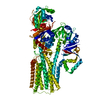
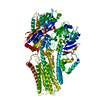



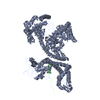
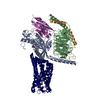



 PDBj
PDBj




